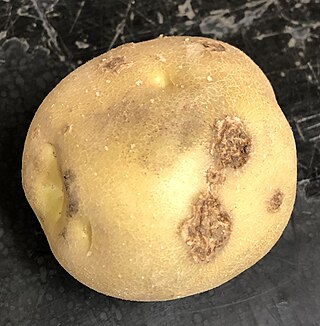
Streptomyces is the largest genus of Actinomycetota, and the type genus of the family Streptomycetaceae. Over 700 species of Streptomyces bacteria have been described. As with the other Actinomycetota, streptomycetes are gram-positive, and have very large genomes with high GC content. Found predominantly in soil and decaying vegetation, most streptomycetes produce spores, and are noted for their distinct "earthy" odor that results from production of a volatile metabolite, geosmin. Different strains of the same species may colonize very diverse environments.

Natamycin, also known as pimaricin, is an antifungal medication used to treat fungal infections around the eye. This includes infections of the eyelids, conjunctiva, and cornea. It is used as eyedrops. Natamycin is also used in the food industry as a preservative.

Glufosinate is a naturally occurring broad-spectrum herbicide produced by several species of Streptomyces soil bacteria. Glufosinate is a non-selective, contact herbicide, with some systemic action. Plants may also metabolize bialaphos and phosalacine, other naturally occurring herbicides, directly into glufosinate. The compound irreversibly inhibits glutamine synthetase, an enzyme necessary for the production of glutamine and for ammonia detoxification, giving it antibacterial, antifungal and herbicidal properties. Application of glufosinate to plants leads to reduced glutamine and elevated ammonia levels in tissues, halting photosynthesis and resulting in plant death.

Streptomycetaceae is a family of the class Actinomycetota, making up the monotypic order Streptomycetales. It includes the important genus Streptomyces. This was the original source of many antibiotics, namely streptomycin, the first antibiotic against tuberculosis.

Streptomyces griseus is a species of bacteria in the genus Streptomyces commonly found in soil. A few strains have been also reported from deep-sea sediments. It is a Gram-positive bacterium with high GC content. Along with most other streptomycetes, S. griseus strains are well known producers of antibiotics and other such commercially significant secondary metabolites. These strains are known to be producers of 32 different structural types of bioactive compounds. Streptomycin, the first antibiotic ever reported from a bacterium, comes from strains of S. griseus. Recently, the whole genome sequence of one of its strains had been completed.
Streptomyces albus is a bacterial species from which the pseudodisaccharide aminoglycoside salbostatin was isolated. S. albus is known to produce white aerial mycelium.

Streptomyces hygroscopicus is a bacterial species in the genus Streptomyces. It was first described by Hans Laurits Jensen in 1931.
Streptomyces avermitilis is a species of bacteria in the genus Streptomyces. This bacterium was discovered by Satoshi Ōmura in Shizuoka Prefecture, Japan.

Common scab is a plant disease of root and tuber crops caused by a small number of Streptomyces species, specifically S. scabies, S. acidiscabies, S. turgidiscabies and others. Common scab mainly affects potato, but can also cause disease on radish, parsnip, beet, and carrot. This plant disease is found wherever these vegetables are grown.

Nourseothricin (NTC) is a member of the streptothricin-class of aminoglycoside antibiotics produced by Streptomyces species. Chemically, NTC is a mixture of the related compounds streptothricin C, D, E, and F. NTC inhibits protein synthesis by inducing miscoding. It is used as a selection marker for a wide range of organisms including bacteria, yeast, filamentous fungi, and plant cells. It is not known to have adverse side-effects on positively selected cells, a property cardinal to a selection drug.
Streptomyces albidoflavus is a bacterium species from the genus of Streptomyces which has been isolated from soil from Poland. Streptomyces albidoflavus produces dibutyl phthalate and streptothricins.
Streptomyces cinnamoneus is a bacterium species from the genus of Streptomyces which has been isolated from soil in Japan. Streptomyces cinnamoneus produces duramycin A, duramycin B, duramycin C, carbomycin, cinnomycin and fungichromin.
Streptomyces hiroshimensis is a bacterium species from the genus of Streptomyces which has been isolated from soil. Streptomyces hiroshimensis produces the red pigment prodigiosin.
Streptomyces microflavus is a bacterium species from the genus of Streptomyces which has been isolated from soil. Streptomyces microflavus produces nemadectin, fattiviracin A1, milbemycin and deoxyuridines. Streptomyces microflavus also produces the ionophore valinomycin. Streptomyces microflavus is also known to cause potato common scab disease in Korea.
Cytochrome P450, family 107, also known as CYP107, is a cytochrome P450 monooxygenase family in bacteria, found to be conserved and highly populated in Streptomyces and Bacillus species. The first gene identified in this family is Cytochrome P450 eryF (CYP107A1) from Saccharopolyspora erythraea. Many enzymes of this family are involved in the synthesis of macrolide antibiotics. The members of this family are widely distributed in Alphaproteobacteria, cyanobacterial, Mycobacterium, Bacillota, and Streptomyces species, which may be due to horizontal gene transfer driven by selection pressure.
Mangrovimonas spongiae is a Gram-negative, rod-shaped and motile bacterium from the genus of Mangrovimonas which has been isolated from a marine sponge from the Yangpu Bay in China.
Zhouia spongiae is a Gram-negative, rod-shaped and non-motile bacterium from the genus of Zhouia which has been isolated from a sponge from the Yangpu Bay on Hainan.
Cytochrome P450 family 154 subfamily C member 3 is an actinobacterial Cytochrome P450 enzyme originally from Streptomyces, which catalyzes the 16α-hydroxylation of various steroids.
Nonlabens spongiae is a Gram-negative, strictly aerobic, rod-shaped and motile bacterium from the genus of Nonlabens which has been isolated from a marine sponge from the Bahamas.






